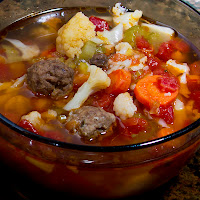Food is an important part of my life.
One of the greatest things about growing up was that both my father and mother enjoyed cooking, and they were good at it.My father learned to cook from his mother, who was from German stock. However, he was born and raised in New York, so there were also a lot of influences throughout the communities he lived in, socialized in and worked in. Although my father cooked a variety of things, one of the constants was that he cooked A LOT of it. It was as if he was cooking for the troops every time he made something, whether it was a roast, soup, pancakes…but, with three growing boys in the home there had to be plenty of food. What wasn’t consumed right away may have been sealed in jars or frozen, or eaten as leftovers the next day. If it was simply put in the fridge, it wouldn’t last very long.
My mother came well equipped with a number of European dishes, having been born and raised in the Netherlands. There is such a variety of foods that come from that culture, due to their proximity to other countries’ influences, the country having been a Colonial Power and their connection to the early trade routes. My mother’s meal plan was a bit different from my father’s. My father might have cooked a couple of large, hot meals a day, whereas my mother would be fine with some bread and cheese (perhaps some lunch meat) in the morning and then in the afternoon, but then prepare a hearty, hot meal in the evening.
One of the common items in the Birdsall Kitchen was SOUP! Between the two of them, there were several different types of soup that we would enjoy. They were typically robust and it didn’t take much to fill you.
 |
| Groentesoep (balletjes, carrots, cauliflower, celery, onions, tomatoes) |
My mother refers to this soup as Groentesoep, even though they always put balletjes in it. One of the great things about cooking is that you can change things around to suit your own liking. I chose not to put any rice (or fine noodles, like my mother does) in my soup, since I had put in so many vegetables. I started by boiling a piece of meat, on the bone, with a couple of bouillon cubes. Once the meat was ready to fall off the bone, I took it out and added my vegetables; carrots, celery, onions (my mother does not use onions), diced tomatoes and cauliflower (put this in later, because it cooks quickly). While that was cooking, I was cutting up the meat and also making the balletjes (season the meat the way you would like), which are simply put in the pot and allowed to cook in the soup.
 |
| Hollandse Brood Rolled oats, flour, honey, salt, yeast & water. |
Although there is some physical labor involved in making the dough (all of the kneading), the toughest part is the waiting. I mixed all of the ingredients and then had to set the dough aside to rise (two hours). After that, cut into it, divide it (yielded two loaves), put it in the pans and then set it aside to rise AGAIN. Meanwhile, the smell in the house is already creating a Pavlovian response, and I haven’t even started baking it yet. About an hour-and-a-half later, I am finally ready to put the bread in the oven…another 50 minutes…ugghhhh. I will say, the 4 ½ hours did give me plenty of time to clean the kitchen counters, the kitchen floor, the two and a half bathrooms (including the floors and tubs) and the floor in the laundry room, with some time to rest.
When I told my older brother that I was making homemade bread, he said he remembered all of the time and energy our parents put into making the bread, which we would consume in, what seemed like, ½ and hour.
By the time I was done cleaning, I was ready to eat. The bowl of soup and two thick slices of bread were more than enough to satisfy me.
Eet Smakelijk - Good Appetite

Looks delicious!..jummie..
ReplyDelete